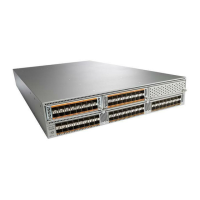CHAPTER
Send feedback to nx5000-docfeedback@cisco.com
1-1
Cisco Nexus 5000 Series Switch CLI Software Configuration Guide
OL-16597-01
1
Configuring SAN Port Channels
SAN port channels refer to the aggregation of multiple physical interfaces into one logical interface to
provide higher aggregated bandwidth, load balancing, and link redundancy.
On Cisco Nexus 5000 Series switches, SAN port channels can include physical Fibre Channel interfaces,
but not virtual Fibre Channel interfaces. A SAN port channel can include up to eight Fibre Channel
interfaces.
This chapter discusses the SAN port channel feature provided in the switch and includes the following
sections:
• Information About SAN Port Channels, page 1-1
• Configuring SAN Port Channels, page 1-5
• Interfaces in a SAN Port Channel, page 1-9
• Port Channel Protocol, page 1-12
• Verifying SAN Port Channel Configuration, page 1-16
• Default Settings, page 1-17
Information About SAN Port Channels
A SAN port channel has the following functionality:
• Provides a point-to-point connection over ISL (E ports) or EISL (TE ports). Multiple links can be
combined into a SAN port channel.
• Increases the aggregate bandwidth on an ISL by distributing traffic among all functional links in the
channel.
• Load balances across multiple links and maintains optimum bandwidth utilization. Load balancing
is based on the source ID, destination ID, and exchange ID (OX ID).
• Provides high availability on an ISL. If one link fails, traffic previously carried on this link is switched
to the remaining links. If a link goes down in a SAN port channel, the upper layer protocol is not
aware of it. To the upper layer protocol, the link is still there, although the bandwidth is diminished.
The routing tables are not affected by link failure.
Cisco Nexus 5000 Series switches support a maximum of four SAN port channels (with eight interfaces
per port channel). A port channel number refers to the unique (within each switch) identifier associated
with each channel group. This number ranges from 1 to 256.

